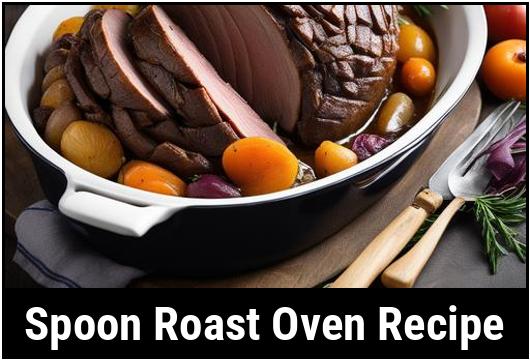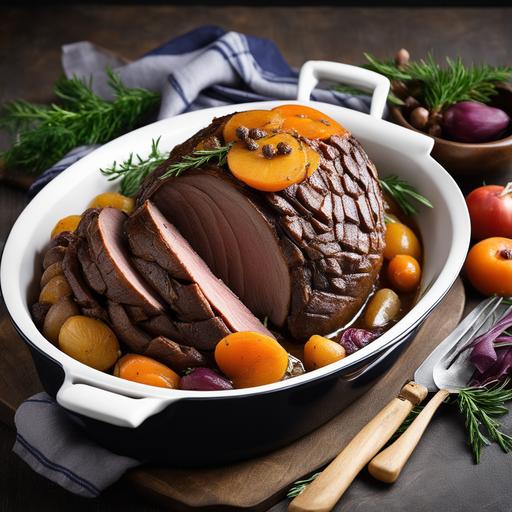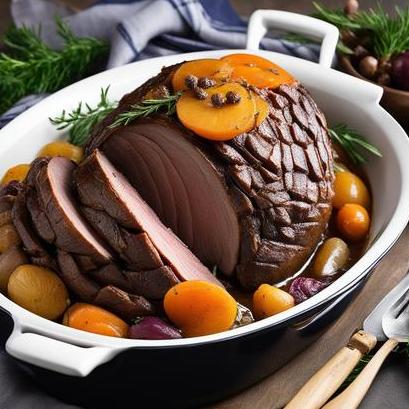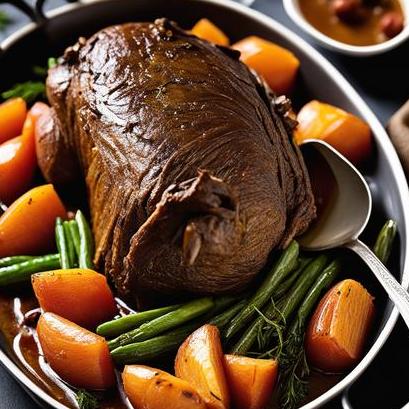
Spoon Roast Oven Recipe: Elevating Your Culinary Experience
Cooking is an art, and the oven is your canvas. When it comes to creating a masterpiece, the spoon roast oven recipe is a true work of culinary genius. With its succulent flavors and tender texture, this dish is sure to tantalize your taste buds. In this comprehensive guide, we will delve into the food science behind this delightful dish, explore culinary details, walk you through the selection and cleaning process, provide invaluable tips and variations, offer doneness checks and troubleshooting advice, and ultimately present you with a delectable spoon roast oven recipe. Prepare yourself for a culinary adventure like no other!
The Science Behind Spoon Roast Oven Recipe: Unveiling the Magic
Before delving into the nitty-gritty of preparation, let’s uncover the food science behind the spoon roast oven recipe. One crucial aspect of this recipe lies in the cut of meat chosen. Ideally, you want to select a tender cut, such as beef chuck roast or top round roast. These cuts are marbled with fat, which imparts flavor and helps keep the meat moist during the cooking process.
Additionally, when exposing the meat to high heat in the oven, the proteins present in the muscle fibers undergo a process known as the Maillard reaction. This reaction causes browning, thus enhancing the depth of flavor and creating a pleasant crust on the outside. Simultaneously, the slow cooking process tenderizes the connective tissue, transforming tough cuts into succulent bites of perfection.
Selecting the Ideal Cut: Ensuring Optimal Flavor and Texture
In any culinary masterpiece, ingredient selection plays a pivotal role. When choosing a cut of meat for the spoon roast oven recipe, it is important to consider factors like tenderness, marbling, and fat content. Let’s explore two popular options:
-
Beef Chuck Roast: This cut, taken from the shoulder region of the animal, boasts exceptional tenderness and generous marbling. Its rich, beefy flavor makes it a prime choice for the spoon roast oven recipe.
-
Top Round Roast: Derived from the rear leg of the animal, this lean cut offers a mildly tender texture. While it lacks the marbling found in beef chuck roast, it can still produce a delicious spoon roast when cooked with the right techniques and seasonings.
To ensure optimal flavor and texture, look for well-marbled cuts with a bright red color. Choosing organic, grass-fed beef can also elevate the overall quality and taste of your spoon roast.
Cleaning and Preparing Your Cut: A Necessity for Culinary Excellence

Great dishes begin with meticulous preparation. When dealing with raw meat, it is crucial to adhere to food safety guidelines. Here’s a step-by-step guide for cleaning and preparing your cut:
-
Cleaning: Rinse the meat under cool water to remove any traces of blood or loose particles. Pat it dry with paper towels to promote better browning during cooking.
-
Trimming: Inspect the meat for excessive fat or any tough and sinewy connective tissues. Trim away excess fat, leaving a thin layer to enhance flavor and moistness.
-
Seasoning: Liberally salt and pepper all sides of the meat, creating a base of complementary flavors. Feel free to experiment with additional seasonings like garlic powder, herbs, or a dash of paprika to infuse your spoon roast with depth.
Tips and Tricks: Elevating Your Spoon Roast

Now that we’ve covered the foundational aspects of the spoon roast oven recipe, let’s move on to some valuable tips and variations to take your culinary creation to new heights:
-
Marinating: For an even more flavorful spoon roast, consider marinating your meat overnight. Whisk together a mixture of olive oil, crushed garlic, fresh herbs, and a splash of Worcestershire sauce. Coat the meat thoroughly, cover, and refrigerate. This process adds a delightful complexity of flavors.
-
Searing for Extra Depth: Before placing your cut in the oven, sear it in a hot skillet for a few minutes on each side. This technique will create a beautiful crust, sealing in juices and intensifying the overall flavor of your spoon roast.
-
Roasting Vegetables: To elevate your dish further, add a medley of root vegetables such as carrots, potatoes, and onions to the roasting pan. These vegetables will absorb the savory drippings from the meat, creating a complementary side dish bursting with flavor.
Doneness Checks: Visual and Practical Verifiers

Achieving the perfect level of doneness is crucial to ensure your spoon roast retains its inherent tenderness and juiciness. Consider these tried-and-true methods for checking doneness:
-
Temperature: Invest in a reliable meat thermometer to accurately gauge the internal temperature of your spoon roast. For rare, aim for 125°F (51°C), medium-rare at 135°F (57°C), medium at 145°F (63°C), and well done at 160°F (71°C). Insert the thermometer into the thickest part of the meat, avoiding contact with any bones.
-
Color and Texture: Visual cues can also guide you towards the desired doneness. For a rare roast, the meat should be deep red in the center, transitioning to a pinkish hue towards the edges. A medium to well-done roast will visibly lose its pinkness and firm up slightly, retaining a slight shade of pink in the center.
The Ultimate Spoon Roast Oven Recipe: A Culinary Delight

Finally, the moment you’ve been waiting for – the spoon roast oven recipe itself. Brace yourself for a gastronomic experience that will leave your guests in awe:
Ingredients:
-
1 beef chuck roast or top round roast (approximately 3-4 pounds)
-
Salt and pepper to taste
-
Additional seasonings: garlic powder, herbs, paprika (optional)
-
Root vegetables (optional)
Instructions:
-
Preheat your oven to 325°F (163°C).
-
Clean your chosen cut of meat following the steps mentioned earlier.
-
Season your meat generously with salt, pepper, and any desired additional seasonings.
-
Optional: If marinating, combine the marinade ingredients in a bowl and coat the meat thoroughly. Cover and refrigerate overnight.
-
Heat a skillet over medium-high heat and sear each side of the meat for 2-3 minutes until a golden-brown crust forms.
-
Place your seared spoon roast in a roasting pan, and if desired, surround it with freshly cut root vegetables.
-
Transfer the roasting pan to the preheated oven and cook for about 20 minutes per pound. Remember to periodically baste the meat with the delicious pan drippings.
-
Monitor the internal temperature of the meat using a meat thermometer until your desired level of doneness is achieved.
-
Once cooked to perfection, remove the spoon roast from the oven and let it rest for approximately 10-15 minutes. This resting period allows the juices to redistribute throughout the meat, ensuring a tender and succulent outcome.
-
Slice your spoon roast against the grain, and serve with the aromatic pan drippings and any roasted vegetables as a sumptuous side dish.
Avoiding the Perils of Overcooking and Undercooking
Sometimes kitchen mishaps occur, but fear not! Here are some crucial pointers to salvage your spoon roast:
-
Overcooked: If you accidentally overcook your spoon roast, all hope is not lost. Simply slice the meat thinly, add a splash of flavorful broth or gravy, and enjoy it as a sandwich filling or integrate it into a hearty stew. Although different in texture, the flavors will still delight your palate.
-
Undercooked: In the event of undercooked meat, return it to the oven for additional cooking time. Keep a close eye on the internal temperature to avoid overcooking. Remember, patience is key to achieving culinary excellence.
Conclusion: A Journey of Flavor and Mastery
In this comprehensive guide, we have explored the science, culinary details, selection, cleaning, preparation, tips, variations, doneness checks, recipe, and even troubleshooting aspects of the spoon roast oven recipe. Armed with newfound knowledge, you are now ready to embark on a culinary adventure that will leave you with a spoon roast that exudes tenderness, flavor, and a touch of mastery. So go forth, savor the process, and indulge in the rewards of your gastronomic prowess. It’s time to elevate your cooking to new heights with a remarkable spoon roast oven recipe!
Sources
FAQS On Spoon Roast Oven Recipe
What Is A Spoon Roast?
A spoon roast, also known as a chuck roast or blade roast, is a cut of beef that comes from the shoulder area. It is a flavorful and tender cut that is perfect for roasting in the oven.
How Do I Prepare A Spoon Roast For Cooking?
Before cooking your spoon roast, it is recommended to bring it to room temperature. This allows for more even cooking. Trim off any excess fat and season the roast with your favorite herbs, spices, and seasonings.
Can I Marinate A Spoon Roast Before Cooking?
While marinating is not necessary for a spoon roast, it can certainly add flavor. You can marinate the roast in a mixture of herbs, spices, vinegar, and oil for a few hours or overnight in the refrigerator.
What Is The Best Way To Cook A Spoon Roast In The Oven?
The best way to cook a spoon roast in the oven is to first sear it on all sides in a hot skillet to develop a rich color and flavor. Then transfer the roast to a preheated oven and roast at a low temperature, around 325°F (163°C), until it reaches your desired level of doneness. A meat thermometer is recommended to ensure accuracy.
How Long Should I Cook A Spoon Roast In The Oven?
The cooking time for a spoon roast can vary depending on the size of the roast and your preferred level of doneness. As a general guideline, you can cook a spoon roast for approximately 25-30 minutes per pound. However, it is always best to rely on a meat thermometer to determine the doneness. Aim for an internal temperature of 135°F (57°C) for medium-rare or 145°F (63°C) for medium. Remember to let the roast rest for a few minutes before slicing to allow for the juices to redistribute within the meat.


